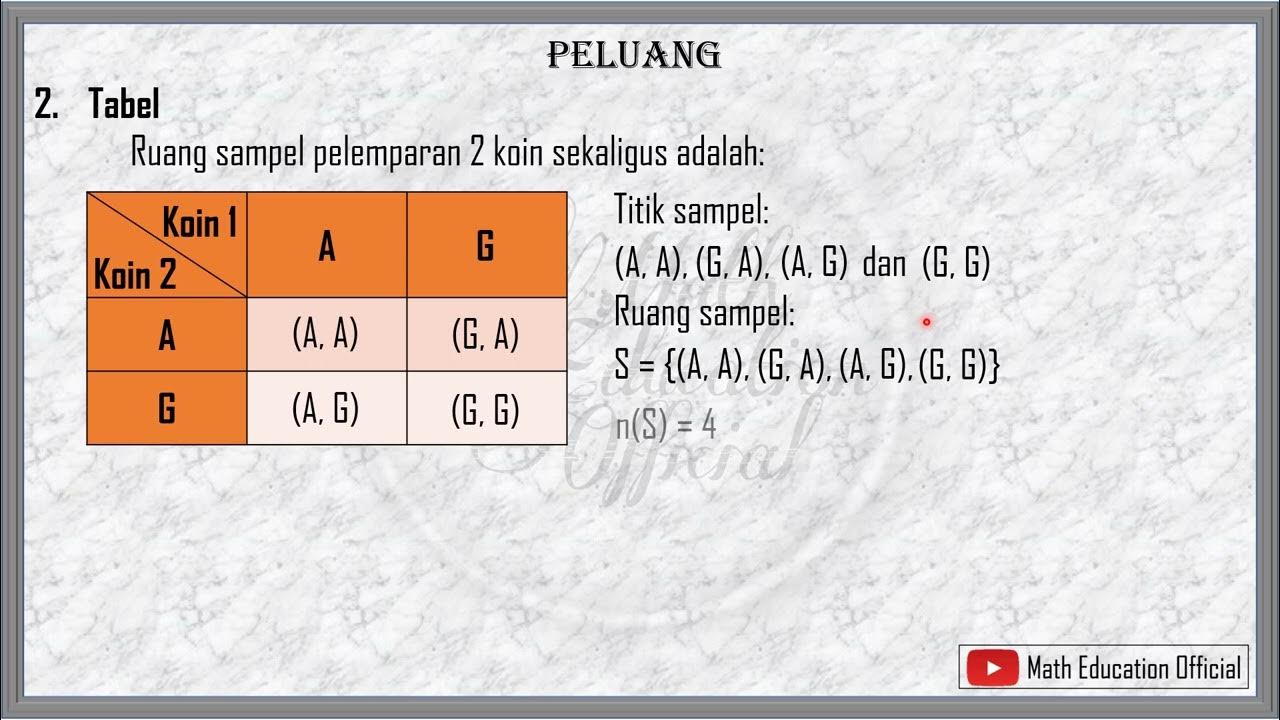Penggunaan Analisis Kombinatorik ~ Teknik Mencacah ~ dalam Perhitungan Peluang
Summary
TLDRThe video discusses combinatorial analysis in probability, focusing on counting sample points in a sample space. It explains two key factors: whether the experiment is with or without replacement, and whether the order matters. The video also demonstrates calculating the probability of selecting faulty light bulbs from a set of 15, where 5 are faulty. Examples are provided for different scenarios, including finding the probabilities of selecting no faulty bulbs, exactly one faulty bulb, and at least one faulty bulb. The importance of prayer and the value of sharing beneficial knowledge are also emphasized.
Takeaways
- 😀 Combinatorial analysis is essential for calculating probabilities, especially in determining sample points within a sample space.
- 🙏 Always begin with a prayer for the knowledge to be beneficial and blessed.
- 🔄 In experiments, if there's replacement, the sample points are calculated using the formula n^k, where n is the number of outcomes and k is the number of trials.
- 🤔 For experiments without replacement, whether or not order matters will determine whether to use combinations or permutations.
- 🧮 The combination formula is used when order doesn't matter, calculated as n! / [k!(n-k)!].
- 📊 The permutation formula is used when order matters, calculated as n! / (n-k)!.
- 💡 Example problem: Selecting 3 light bulbs from 15 bulbs (5 broken, 10 intact) is solved using combinatorial methods.
- ⚖️ To calculate the probability of an event (like choosing broken bulbs), divide the favorable outcomes by the total possible outcomes in the sample space.
- 🔢 In a situation where bulbs are chosen without replacement and order isn't considered, use combination formulas to find the number of outcomes.
- 📉 Probabilities like choosing exactly one broken bulb or at least one broken bulb are calculated by summing up specific combinations and dividing by the total number of outcomes.
Q & A
What is the main focus of the discussion in this video?
-The video focuses on using combinatorial analysis to calculate probabilities, specifically how to count sample points in a sample space when performing an experiment multiple times.
What is the importance of distinguishing between 'with replacement' and 'without replacement' in probability experiments?
-In probability experiments, 'with replacement' means the same item can be selected more than once, leading to n^k different outcomes. In 'without replacement,' each item can only be chosen once, and whether order matters influences the use of combinations or permutations.
How is the formula for combinations different from that of permutations?
-The formula for combinations, used when order doesn't matter, is n! / (k!(n-k)!), whereas for permutations, where order matters, the formula is n! / (n-k)!. Both are used to count different ways of selecting k items from n.
What example is used in the video to explain the concept of combinatorial analysis?
-The example involves selecting 3 light bulbs at random from a set of 15, where 5 bulbs are defective. The goal is to calculate the probabilities of different events, such as having no defective bulbs or at least one defective bulb.
How is the total number of possible outcomes calculated in the example of light bulbs?
-Since the order doesn't matter and it's without replacement, the total number of outcomes is calculated using combinations: 15 choose 3, which is 455.
How is the probability of selecting no defective bulbs calculated?
-The number of ways to select 0 defective bulbs is 5 choose 0 (for the defective bulbs) multiplied by 10 choose 3 (for the non-defective bulbs). This yields 120 ways, and the probability is 120 / 455, which equals approximately 0.2637.
How is the probability of selecting exactly one defective bulb calculated?
-The number of ways to select exactly 1 defective bulb is 5 choose 1 multiplied by 10 choose 2. This gives 225 ways, and the probability is 225 / 455, which equals approximately 0.4945.
What does the video mean by 'mutually exclusive' events in this context?
-Mutually exclusive events refer to events where the occurrence of one event excludes the occurrence of another. For example, selecting a defective bulb and a non-defective bulb in the same sample are mutually exclusive outcomes.
How is the probability of having at least one defective bulb calculated?
-The probability of having at least one defective bulb is calculated using the complement rule. First, the probability of no defective bulbs (P(R=0)) is found, and then subtracted from 1 to get P(R≥1). In this case, it's 1 - 0.2637 = 0.7363.
What is the significance of applying the complement rule in probability?
-The complement rule is significant because it simplifies calculations. Instead of calculating the probabilities of multiple outcomes directly, it's often easier to calculate the probability of the complement (the opposite event) and subtract it from 1.
Outlines

هذا القسم متوفر فقط للمشتركين. يرجى الترقية للوصول إلى هذه الميزة.
قم بالترقية الآنMindmap

هذا القسم متوفر فقط للمشتركين. يرجى الترقية للوصول إلى هذه الميزة.
قم بالترقية الآنKeywords

هذا القسم متوفر فقط للمشتركين. يرجى الترقية للوصول إلى هذه الميزة.
قم بالترقية الآنHighlights

هذا القسم متوفر فقط للمشتركين. يرجى الترقية للوصول إلى هذه الميزة.
قم بالترقية الآنTranscripts

هذا القسم متوفر فقط للمشتركين. يرجى الترقية للوصول إلى هذه الميزة.
قم بالترقية الآنتصفح المزيد من مقاطع الفيديو ذات الصلة

Peluang [Part 1] - Ruang Sampel dan Titik Sampel

MENENTUKAN RUANG SAMPEL DAN TITIK SAMPEL PELUANG PART 1

RUANG SAMPEL: Mencacah Titik Sampel dengan Analisis Kombinatorik

The Probability of the Union of Events (6.3)

Mengenal Ruang Sampel, Titik Sampel dan Kejadian

MEMAHAMI PENGERTIAN PELUANG | Matematika SMP/MTs Kelas 8
5.0 / 5 (0 votes)
